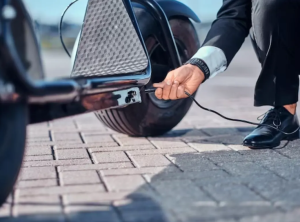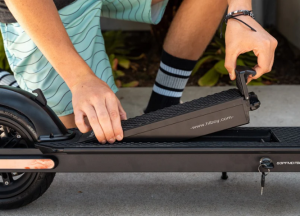Use the correct charger, avoid overcharging, and maintain battery between 20%-80% charge.
Understanding Electric Scooter Batteries
Understanding Electric Scooter Batteries is crucial for maximizing the efficiency, reliability, and longevity of your electric scooter. By exploring the types of batteries, their operational mechanics, and the critical role of maintenance, you can significantly enhance your scooter’s performance and lifespan.
Types of Batteries Used in Electric Scooters
In the realm of electric scooters, the battle of batteries mainly sees two contenders: Lithium-ion (Li-ion) and Sealed Lead Acid (SLA). Lithium-ion batteries shine with their lightweight and superior energy density, offering extended distances on a single charge. Conversely, Sealed Lead Acid batteries bring affordability and ruggedness to the table, albeit with the trade-off of increased weight and a less impressive energy density.
To provide a clearer picture, let’s dive into a detailed comparison of Li-ion and SLA batteries:
| Feature | Lithium-ion | Sealed Lead Acid |
|---|---|---|
| Weight | Significantly lighter, enhancing scooter portability | Noticeably heavier, which may affect portability |
| Energy Density | High, enabling longer distances per charge | Lower, resulting in shorter travel distances per charge |
| Lifespan | Can reach up to 1000 charge cycles, ensuring longevity | Typically around 300-500 charge cycles, shorter in comparison |
| Cost | Higher, reflecting the advanced technology used | More affordable, offering a budget-friendly option |
| Maintenance Needs | Minimal, reducing the hassle of upkeep | Requires more attention, including periodic checks |
| Environmental Impact | Lower, making them a more eco-friendly choice | Higher, due to the lead content and disposal impact |
How Electric Scooter Batteries Work
At the heart of electric scooter batteries is a dynamic process where electrical energy transforms into mechanical energy to power the motor. This transformation relies on a seamless flow of electrons, moving from the battery’s anode to its cathode through an electrolyte solution. This electron flow generates the necessary electrical current to drive the motor and propel the scooter forward.
The Importance of Battery Maintenance for Longevity
Beyond regular charging, optimal battery maintenance is key to extending its service life and maintaining your scooter’s performance. Engaging in regular cleaning of battery contacts to prevent corrosion, and storing the scooter in environments that avoid extreme temperatures are essential practices. Avoiding prolonged periods of battery discharge is crucial to prevent irreversible damage.
Equally important is recognizing the significance of the battery’s charge cycle and steering clear of overcharging. Overcharging can lead to overheating and may significantly diminish the battery’s lifespan. Insights from Battery University highlight that lithium-ion batteries could lose up to 20% of their capacity after just 400 charge cycles if neglected.
By adopting these informed charging and maintenance practices for your electric scooter’s battery, you not only boost its lifespan but also enhance the overall performance and reliability of your scooter. Armed with the right knowledge and habits, you stand to maximize the enjoyment and value derived from your electric scooter, ensuring it serves you well for many rides to come.
Optimal Charging Techniques
Optimal Charging Techniques play a pivotal role in maintaining and extending the life of your electric scooter’s battery. By focusing on selecting the right charger, adhering to a step-by-step charging guide, and implementing tips to maximize battery life, you can ensure that your scooter remains a reliable mode of transportation.
Finding the Right Charger for Your Scooter
Selecting the appropriate charger for your electric scooter is not just about convenience; it’s about ensuring the longevity of your battery. Always opt for a charger that matches the manufacturer’s specifications for voltage and current. Using a charger with a higher voltage than recommended can lead to overheating, while a lower voltage might not adequately charge the battery, leading to reduced performance. The ideal charger should provide a balance between efficient charging times and safety, with most manufacturers recommending a charger that delivers a charge rate of about 0.5 to 1.0 times the battery’s capacity in amp-hours (Ah). For instance, for a 10Ah battery, a charger rated at 5-10A is optimal.
Charging Your Electric Scooter: Step-by-Step Guide
Proper charging techniques are essential to maximize battery performance and lifespan. Follow these steps to ensure optimal charging:
Before plugging in the charger, make sure the scooter and the battery are at room temperature. Charging a cold battery can cause internal damage, reducing its lifespan.
Connect the charger to the scooter before plugging it into the electrical outlet. This sequence minimizes the risk of sparking, which can damage the battery.
Monitor the charging process. Although many scooters come with chargers that automatically stop charging once the battery is full, checking periodically ensures everything is working as intended.
Once the battery is fully charged, disconnect the charger from the power outlet first, then from the scooter. This practice helps prevent any potential electrical surges from damaging the battery.
Tips for Maximizing Battery Life During Charging
Enhancing battery life extends beyond just following the right charging steps. Implement these tips to further maximize your battery’s lifespan:
Avoid leaving the battery fully charged or fully depleted for extended periods. Lithium-ion batteries thrive when kept between 20% and 80% charge. Studies suggest that maintaining a battery at 100% charge can significantly reduce its lifespan compared to keeping it at 50% charge when not in use.
Use a smart charger that can automatically adjust the charging current based on the battery’s condition. Smart chargers can prolong the life of your battery by preventing overcharging and applying a more gentle charging curve, essential for maintaining battery health.
Keep the battery and the scooter in a cool, dry place away from direct sunlight while charging. Excessive heat can degrade the battery faster. Ideally, the temperature should be maintained between 50°F and 77°F (10°C to 25°C) for optimal charging conditions.
By incorporating these techniques and habits into your charging routine, you significantly enhance the durability, performance, and reliability of your electric scooter’s battery. This approach not only saves you money in the long run by reducing the need for frequent battery replacements but also contributes to a more sustainable and enjoyable riding experience.
Common Charging Mistakes to Avoid
Avoiding certain pitfalls when charging your electric scooter can greatly enhance your battery’s health and ensure your scooter is always ready for your next ride.
Overcharging and Its Effects on Battery Health
One might think that leaving an electric scooter plugged in ensures it’s always ready to go, but overcharging can have detrimental effects on battery health. Lithium-ion batteries, the type most commonly used in electric scooters, are particularly susceptible to overcharge-related stress. This stress can lead to overheating, capacity loss, and in severe cases, battery swelling, which could permanently damage the battery. Research indicates that a lithium-ion battery continuously kept at a full charge can lose up to 20% of its capacity within a year, whereas one kept at 50% charge retains most of its capacity even after several years of use.
To avoid overcharging, use a smart charger that automatically stops charging once the battery is full. Make it a practice to unplug your scooter once it has reached a full charge, ideally within a few hours of reaching 100%.
Undercharging and Its Impact on Scooter Performance
Just as overcharging can be harmful, regularly undercharging your electric scooter’s battery can also negatively affect its performance and longevity. Batteries that are frequently discharged below 20% of their capacity before being recharged may experience “deep discharge” states, which can lead to a decrease in the overall number of charge cycles the battery can undergo.
Undercharging can result in insufficient power being available to the scooter, leading to reduced performance, slower speeds, and a decreased range. To optimize battery life and scooter performance, ensure that your battery is charged to at least 80% before use, especially if planning for longer rides.
Using Non-Compatible Chargers
The temptation to use a non-compatible charger, perhaps due to its availability or the misplaced notion that all chargers are the same, can lead to serious consequences for your electric scooter’s battery. Non-compatible chargers may supply incorrect voltage or current, leading to inefficient charging, battery damage, or even hazardous situations such as fires.
For example, using a charger with a higher voltage output than your battery is designed to handle can cause rapid overheating, while a lower voltage charger might not fully charge the battery, reducing its usable life. Always use the charger provided by your scooter’s manufacturer, or if a replacement is necessary, ensure it matches the original’s specifications in terms of voltage, current, and connector type.
By steering clear of these common charging mistakes, you not only safeguard your electric scooter’s battery health but also enhance its performance and reliability. Adopting best practices for charging is an investment in the longevity of your scooter, ensuring it remains a dependable mode of transportation for years to come.
Advanced Battery Care and Maintenance
Taking your electric scooter’s battery maintenance to the next level not only ensures optimal performance but also significantly extends its lifespan. By integrating regular maintenance tips, proper storage techniques, and understanding how to handle battery wear and replacement, you can maintain your scooter’s reliability and efficiency.
Regular Battery Maintenance Tips
Frequent inspections and cleanings form the cornerstone of effective battery maintenance. Ensure the battery terminals are free from corrosion and buildup, which can impede electrical conductivity. You can gently clean the terminals with a solution of baking soda and water, applying it with a soft brush. After cleaning, thoroughly dry the terminals before reconnecting the battery.
Balancing the battery cells regularly is also crucial. For lithium-ion batteries, using a smart charger that supports balancing will ensure all cells charge at an equal rate, maintaining the battery’s overall health and efficiency. This practice can significantly extend the battery’s usable life, as imbalanced cells can lead to underperformance and accelerated degradation.
Storing Your Electric Scooter Properly
Proper storage of your electric scooter is pivotal, especially during extended periods of inactivity. Ideally, store your scooter in a cool, dry place, away from direct sunlight and extreme temperatures. Batteries tend to degrade faster in high temperatures, so a storage environment between 50°F and 77°F (10°C to 25°C) is optimal.
Keeping the battery charge level between 40% and 80% during storage minimizes stress and prolongs its lifespan. A battery left fully charged or completely discharged for long periods can suffer from reduced capacity and performance.
Handling Battery Wear and Replacement
Over time, even with meticulous care, battery performance will inevitably decline. Monitoring the battery’s capacity and performance is essential to determine the right time for a replacement. A significant decrease in the scooter’s range or speed indicates that the battery is wearing out.
When choosing a replacement battery, opt for one that matches or exceeds the original’s specifications in terms of capacity (Ah), voltage (V), and physical size. Investing in a high-quality battery ensures longer life and better performance. For example, a high-quality lithium-ion battery can cost more upfront but offers up to 1000 charge cycles, compared to the 300-500 cycles of a lower-quality counterpart.
Recycling the old battery properly is just as important as selecting a new one. Batteries contain heavy metals and toxic substances that can harm the environment. Many retailers and local waste management services offer recycling programs for batteries, ensuring they are disposed of in an environmentally friendly manner.
By adhering to these advanced care and maintenance guidelines, you can ensure your electric scooter remains a dependable mode of transportation for years to come. Investing time and effort into proper battery care not only saves money in the long run by reducing the frequency of replacements but also contributes to a more sustainable and environmentally conscious use of electric scooters.


